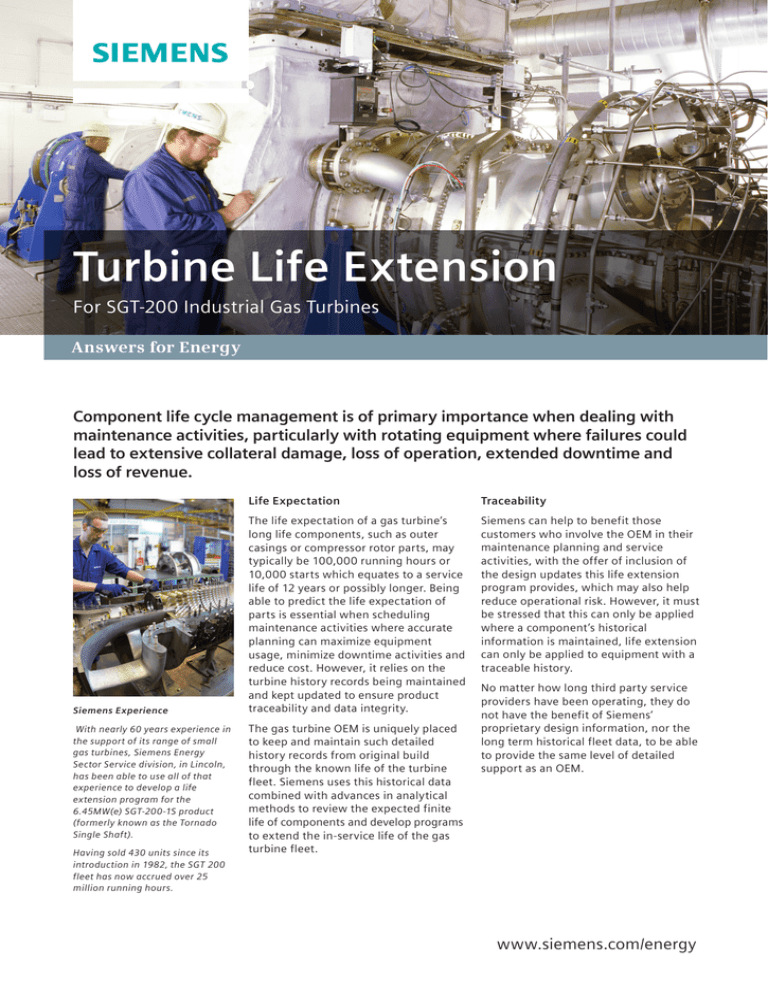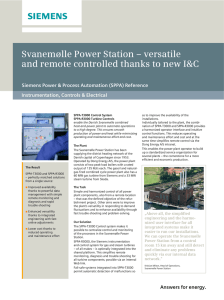
Turbine Life Extension
For SGT-200 Industrial Gas Turbines
Answers for Energy
Component life cycle management is of primary importance when dealing with
maintenance activities, particularly with rotating equipment where failures could
lead to extensive collateral damage, loss of operation, extended downtime and
loss of revenue.
Siemens Experience
With nearly 60 years experience in
the support of its range of small
gas turbines, Siemens Energy
Sector Service division, in Lincoln,
has been able to use all of that
experience to develop a life
extension program for the
6.45MW(e) SGT-200-1S product
(formerly known as the Tornado
Single Shaft).
Having sold 430 units since its
introduction in 1982, the SGT 200
fleet has now accrued over 25
million running hours.
Life Expectation
Traceability
The life expectation of a gas turbine’s
long life components, such as outer
casings or compressor rotor parts, may
typically be 100,000 running hours or
10,000 starts which equates to a service
life of 12 years or possibly longer. Being
able to predict the life expectation of
parts is essential when scheduling
maintenance activities where accurate
planning can maximize equipment
usage, minimize downtime activities and
reduce cost. However, it relies on the
turbine history records being maintained
and kept updated to ensure product
traceability and data integrity.
Siemens can help to benefit those
customers who involve the OEM in their
maintenance planning and service
activities, with the offer of inclusion of
the design updates this life extension
program provides, which may also help
reduce operational risk. However, it must
be stressed that this can only be applied
where a component’s historical
information is maintained, life extension
can only be applied to equipment with a
traceable history.
The gas turbine OEM is uniquely placed
to keep and maintain such detailed
history records from original build
through the known life of the turbine
fleet. Siemens uses this historical data
combined with advances in analytical
methods to review the expected finite
life of components and develop programs
to extend the in-service life of the gas
turbine fleet.
No matter how long third party service
providers have been operating, they do
not have the benefit of Siemens’
proprietary design information, nor the
long term historical fleet data, to be able
to provide the same level of detailed
support as an OEM.
www.siemens.com/energy
Specific Analysis of the operation and
maintenance history by:
Obsolescence
Cost
Reduction
Health &
Safety
Review of the O&M records and the
turbine duty cycle
Selective component sampling
Benefit by
Mods & Ups
Reliability
Fuel analysis & air quality sampling etc.
Environment
IGVs and actuator system
Burners
Alternatively Siemens can offer the
following solution where there is a lack
of traceable history.
Solution
To be able to offer life extension, the
unit will need to be assessed to ensure
its integrity; this may typically cover the
following scope of supply:
Combustor assemblies
Casings
Drive train & couplings
This will establish the current life
capability and what scope of work,
including the latest modifications and
upgrades, will be recommended to attain
the customer’s required turbine life
extension.
Potential Benefits may include:
An opportunity to upgrade previous
technology to the latest standard
and/or materials
Maintain or improve power and/or
efficiency
Reduced operational risk by Trend
Analysis / Condition Health
Monitoring
Reduced downtime
Environmental legislation compliance
Reduced Life Cycle Cost
Controls upgrade to the
Siemens S7-300TM micro
controller.
HEPA intake air filtration
upgrade – improved
filtration to reduce blade
fouling and power loss.
Turbine rotor and stator blading
Continued investment by Siemens into
the advanced analysis of component life
has demonstrated that many of the long
life components can achieve up to
150,000 hours. This can be done without
compromising safety allowing a further
operational cycle before replacement.
However, it is subject to the condition
that the parts have been maintained
correctly over their operational life and
that accumulated operating hours have
been recorded accurately.
Associated Modifications &
Upgrades:
Fuel System update to
incorporate STAR
Integrated fuel valve for
smoother running.
Detailed Check:
Air Intake Filtration and ductwork
Performance
Recommendations
DLE upgrade for low NOx
emissions to meet current
and future legislation
Update by exchange units
for reduced downtime and
inclusion of latest
developments
Product Improvement and
Product Safety Bulletin
inclusion
Remote Monitoring
System to utilize the
technical capability of our
24hr Help desk and, with
the appropriate support
contract, monthly trend
analysis/condition
monitoring reports
Long Term Service
Agreement to provide the
benefits of a fully inclusive
support contract
For a customer concerned
with the safe operation of
his plant, the best way to
ensure that decisions are
based on Siemens’
proprietary information is
by agreeing and planning
the maintenance
program with the OEM.
Published by and copyright © 2013:
Siemens AG
Energy Sector
Freyeslebenstrasse 1
91058 Erlangen, Germany
Siemens Energy, Inc.
4400 Alafaya Trail
Orlando, FL 32826-2399, USA
For more information, please contact
our Customer Support Center.
Phone: +49 180 524 70 00
Fax:
+49 180 524 24 71
(Charges depending on provider)
E-mail:support.energy@siemens.com
www.siemens.com/energy
Energy Service Division
LCN 2013 - F33.23 LN
Printed on elementary chlorine-free
bleached paper.
All rights reserved. Trademarks mentioned in
this document are the property of Siemens AG,
its affiliates, or their respective owners.
Subject to change without prior notice.
The information in this document contains
general descriptions of the technical options
available, which may not apply in all cases.
The required technical options should
therefore be specified in the contract.



